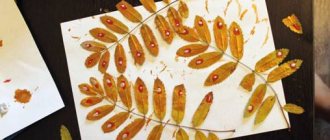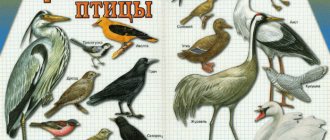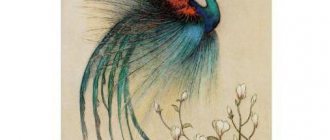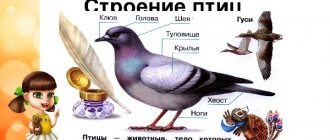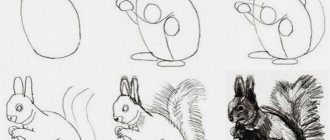Summary of a drawing lesson in the senior group “Birds of Migratory”
Summary of a drawing lesson in the senior group “Birds of Migratory”
Kind of activity:
direct educational
Age group:
senior group
Subject:
"Migratory birds"
Target
: consolidate methods for conveying bird proportions; develop creative imagination; cultivate a caring attitude towards the environment; consolidate and expand knowledge about wintering and migratory birds. We continue to develop fine motor skills; observe the sequential execution of the drawing; cultivate a love for birds.
Software tasks:
Educational:
- practice drawing birds;
- consolidate the methods of making a sketch with a simple pencil and then painting over it with watercolors;
Educational:
- develop the ability to analyze drawings;
-develop memory, thinking, fine motor skills of the hands, and the ability to enjoy the results of one’s work.
Educational:
— caring attitude towards birds and nature;
- to form in children the desire to complete the work they start.
Methods and techniques:
-Visual: looking at illustrations (paying attention to the characteristics of birds - size, color, leg length, beak shape).
-Verbal: conversation, explanation;
Preliminary work:
looking at illustrations of birds, viewing slides “Migratory Birds”.
Material and equipment:
pictures of birds; drawing paper, pencil, eraser, watercolor, brushes, water jar, palette.
Progress of educational activities:
Educator:
- Let's see what birds are sitting on our tree? Name them. (crow, magpie, woodpecker, tit, black grouse)
- Oh, guys, I can’t understand something, are all the birds gathered on the tree? Help me to understand. (Children find out that all birds winter and there are no migratory ones.)
- What happened? Where have the migratory birds gone? (children's answer)
- Guys, let's think, why are birds called migratory? That's right, migratory birds are birds that come to us in the spring, and in the fall they fly to warmer climes. Why do these birds fly away from us in the fall?
-All these birds eat insects. And in the fall the insects disappear. Birds are deprived of their main food and are forced to fly to warmer climes. There are many insects there all year round. Let's list the migratory birds (swallow, crane, stork, cuckoo, swan, starling, wagtail, duck, lark, heron)
- Please look at all of these and name their similarities and differences. (similarities are the body, head, tail, etc.; differences are the color of the plumage). You and I have already drawn a bird with a pencil. Today we will also draw with paints.
Physical exercise “A flock of birds is flying south”
A flock of birds flies south, the sky is blue all around. (Children wave their arms like wings) In order to fly faster, you need to flap your wings. (Children wave their hands more intensely) The sun is shining in a clear sky, An astronaut is flying in a rocket. (Stretching - arms up) And below the forest, fields - The earth is spread out. (Low bend forward, arms spread to the side)
The birds began to descend
Everyone sits down in the clearing.
They have a long way to go, the birds need to rest. (Children sit in a deep squat and sit for a few seconds) And again it’s time to hit the road. We have a lot of flying to do. (Children stand up and flap their “wings”)
Here comes the south. Hooray! Hooray! It's time for us to land. (Children sit at tables)
- Now look at these pictures. Let's name what parts a bird consists of? (head, body, tail, wings) What shape is the head? (round) What shape is the body? (oval) What shape is the tail? (can have a triangular shape, or can be forked, like a swallow) The wings have a curved shape if the bird is flying, and oval when folded. The beak is triangular.
— You know how to draw geometric shapes. Therefore, you can easily depict the components of birds. You just need to connect them correctly.
Practical part:
-First, let's draw an oval body. Then we will draw the head. Oval wings, slightly pointed at the ends - these are the longest feathers. Rectangular tail, triangular beak, round eyes. And then, let's draw the paws, draw the feathers.
— We take simple pencils and make sketches. (children draw). Then we will paint our bird with paints and create a background.
Result:
- Well done boys. You all did your best and we got wonderful birds.
— What migratory birds do we know?
-Well done guys, you did a very good job today. With each lesson your work gets better and better! Well done!
After class, the work is displayed in a corner along with the original pictures, so that other children can look and compare.
drawing migratory birds outline of a drawing lesson (senior group)
Drawing lesson notes
"Migratory birds"
(senior group)
Tasks:
Teach children to draw migratory birds, building an image from its component parts.
Develop skills in drawing a sketch of a picture with a simple pencil.
Consolidate and expand knowledge about wintering and migratory birds.
Cultivate a caring attitude towards birds.
Materials:
Recorded bird voices, image of a tree, pictures of wintering and migratory birds, magpie, letter, samples for drawing birds.
Progress of the lesson :
(The voices of birds are recorded. Children with a teacher enter the group)
Educator:
- Let's see what birds are sitting on our tree? Name them. (Woodpecker, tit, crow, magpie, black grouse)
- Oh, guys, I can’t understand something, are all the birds gathered on the tree? Help me to understand. (Children find out that all birds winter and there are no migratory ones.)
- What happened? Where have the migratory birds gone? But here is some letter from the magpie, let’s take the letter from the magpie and read it.
- Oh, children, an accident happened. It turns out that the Snow Queen, the mistress of winter, captured the birds on the way to the south and does not want to release them into the wild. The birds are asking for your help.
“The snow queen is probably bored of being alone and that’s why she doesn’t want to let the birds go.” I suggest drawing portraits of birds and giving them to her. And then she will release all the birds.
- Guys, let's think, why are birds called migratory? That's right, migratory birds are birds that spend half the year with us, and leave us for the second half of the year, flying to other lands. Why do these birds fly away from us in the fall?
-All these birds eat insects. And in the fall the insects disappear. Birds are deprived of their main food and are forced to fly to warmer climes. There are many insects there all year round.
Physical exercise “A flock of birds is flying south”
A flock of birds flies south, the sky is blue all around. (Children wave their arms like wings) In order to fly faster, you need to flap your wings. (Children wave their hands more intensely) The sun is shining in a clear sky, An astronaut is flying in a rocket. (Stretching - arms up) And below the forest, fields - The earth is spread out. (Low bend forward, arms spread to the side)
The birds began to descend
Everyone sits down in the clearing.
They have a long way to go, the birds need to rest. (Children sit in a deep squat and sit for a few seconds) And again it’s time to hit the road. We have a lot of flying to do. (Children stand up and flap their “wings”)
Here comes the south. Hooray! Hooray! It's time for us to land. (Children sit at tables)
- Now look at these pictures. Looking at them, we understand that the body of birds consists of several parts. Which ones? (head, body, tail, wings) What shape is the head? (round) What shape is the body? (oval) What shape is the tail? (can have a triangular shape, or can be forked, like a swallow) The wings have a curved shape if the bird is flying, and oval when folded. The beak is triangular.
— You know how to draw geometric shapes. Therefore, you can easily depict the components of birds. You just need to connect them correctly.
(Show)
-First, let's draw an oval body. Then we will draw the head. Oval wings, slightly pointed at the ends - these are the longest feathers. Rectangular tail, triangular beak, round eyes. And then, let's draw the paws, draw the feathers.
— We take simple pencils and make sketches.
(children draw)
Result:
- Well done boys. You all did your best and we got wonderful birds. I think the snow queen will be pleased and will definitely let our feathered friends go.
— What migratory birds will we wait for?
Game: “Find the migratory bird”
- You all completed the task. I will give you all invitation tickets to the Birds of Migratory quiz.
Specifics of drawing birds in the senior group of preschool educational institutions
Children 5–6 years old are able to create beautiful, expressive drawings and convey the shape of objects and their components well. Children's horizons broaden significantly: new knowledge is acquired in the process of observing the world around them and reading fiction. The guys can already depict objects that they have never seen (as for birds, this is, for example, a penguin).
The color spectrum with which children work is expanding. The drawing is based on beautiful color combinations.
If in elementary and middle preschool age children depicted birds in the form of checkmarks, then in the older group the teacher’s task is to teach them to draw them correctly. The teacher must form in children an idea of the external appearance of birds, an understanding that they all have a similar structure, although they differ in color, size and shape of body parts. The children learn that all birds have an elongated body and the same head position. When moving, the position of the head and tail changes, and the wings open.
Drawing birds should ideally be preceded by modeling on a similar topic.
In order for preschoolers to realistically depict birds, preliminary work must be carried out before such classes: observing birds on walks, looking at numerous illustrations.
There are some difficulties in drawing birds. Children must learn the basics of depicting them. The drawing begins with an outline - an elongated body in the shape of a large drop (pointed towards the end) and an oval head. After this, wings, a tail, paws and an eye near the beak are added. The accuracy and quality of the entire drawing depends on the correct contour.
The teacher explains to preschoolers how the bird's body parts are located during flight and when moving on the ground (the tail is straightened or folded). In addition, you can draw birds pecking at food or sitting on a tree branch.
Of course, it is better to start depicting birds in the older group with those individuals that children can observe in everyday life: this is a sparrow, titmouse, bullfinch, pigeon, etc. We must teach the children to notice the difference between birds themselves, compare them, highlight key features, then drawing will be easier. For example, an owl is round and fat. The stork is thin-legged with a long graceful beak. The swan has a long neck, is very beautiful, with large, sweeping wings. The penguin seems to be dressed in a tailcoat, clumsy, with short wings, and has a funny crest on its head. The rooster has a powerful chest, strong legs, a beard, a beautiful comb, and most importantly, a multi-colored tail. The bullfinch is distinguished by its red breast.
When preschoolers learn to draw realistic images well, the teacher can invite them to depict a bird in a fairy tale interpretation - “Firebird”, “Bird of Happiness”, “Magic Bird”. Note that this topic is creative, and the teacher offers children several diverse samples for familiarization. In addition, children choose their own colors.
Materials used and base
Birds in the older group are depicted on a sheet of paper of the usual size. When painting with gouache or watercolors, the base is tinted in advance by the teacher. If children have to draw birds soaring in the sky, then it should be a blue background.
For collective work, the teacher offers the children a sheet of whatman paper, where, depending on the nature of the composition, they first draw a tree with many branches, a large feeder, or a village poultry yard.
Preschoolers of this age draw birds with both paints and colored pencils. It is better to paint white birds, for example, a swan, a stork or a goose, with gouache so that they are more visible against a colored background. The same applies to black and white - penguin and swallow. A titmouse, a bullfinch, an owl, a chicken, a sparrow, and a dove can be drawn with colored pencils or even wax crayons. In some cases, felt-tip pens are also suitable, for example, when depicting a bright cockerel.
Drawing with felt-tip pens
To preliminary draw the outline, use a simple pencil.
Techniques and techniques that should be used when drawing in the senior group
When drawing in the older group, the teacher should practice with the children the techniques of correctly painting a silhouette with a brush. Small parts of the body - beak, eyes, paws, tail - are carefully painted on with the tip of the brush. In this case, the instrument should be held in your hand almost vertically. The larger oblong body of the bird and its wings are painted over with all the pile, while the brush is tilted towards the paper. When the paint dries, you can additionally use the tip of the brush to indicate the direction of the feathers - the image will become more realistic.
Hatching with a pencil should be done in one direction, in addition, there should be no white spots inside the outline.
Depending on the size of the part to be painted, preschoolers should adjust the range of their hand movements.
Additional types of visual activities used, the relevance of an individual approach
The image will become more original, and the productive activity itself will be more exciting for children, if you diversify the composition with applicative or plasticine elements. For example, a bird can peck at a worm or caterpillar molded from plasticine (in the form of a flagellum or sequentially stuck balls). Small black eyes of birds can be sculpted from plasticine. If a bird soars in the sky, you can depict the sun using plasticineography. A bullfinch can sit on a rowan branch with sculpted red berries.
Applique details will be especially appropriate when drawing fairy-tale birds. This can be colored foil, shiny sequins or candy wrappers. You can decorate an elegant cockerel in a similar way.
